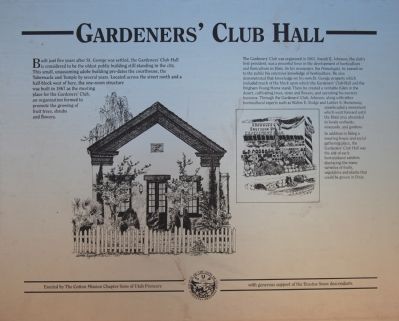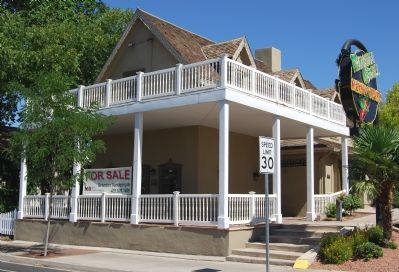St. George in Washington County, Utah — The American Mountains (Southwest)
Gardeners’ Club Hall
The Gardeners’ Club was organized in 1865, Joseph E. Johnson, the club’s first president, was a powerful force in the development of horticulture and floraculture in Dixie. In his newspaper, “The Pomologist” he passed on to the public his extensive knowledge of horticulture. He also demonstrated that knowledge on his own St. George property, which included must of the block on which the Gardeners’ Club Hall and the Brigham Young Home stand. There he created a veritable “Eden” in the desert, cultivating trees, vines, and flowers and operating his nursery business. Through the Gardener’s Club, Joseph Johnson, along with other horticulture experts such as Walter E. Dodge and Luther Hemenway, spearheaded a movement which went forward until the Dixie area abounded in lovely orchards, vineyards, and gardens.
In addition to being a meeting-house and social gathering place, the Gardeners’ Club Hall was the site of early horticulture exhibits, displaying the many varieties of fruits, vegetables, and other plants that could be grown in Dixie.
Erected 1994 by Sons of Utah Pioneers.
Topics and series. This historical marker is listed in these topic lists: Agriculture • Horticulture & Forestry • Notable Buildings. In addition, it is included in the Sons of Utah Pioneers series list. A significant historical year for this entry is 1867.
Location. 37° 6.572′ N, 113° 34.984′ W. Marker is in St. George, Utah, in Washington County. Marker can be reached from St. George Boulevard. It is in park next to Zion’s Bank. Touch for map. Marker is at or near this postal address: 36 E St George Boulevard, Saint George UT 84770, United States of America. Touch for directions.
Other nearby markers. At least 8 other markers are within walking distance of this marker. St. George Social Hall “Opera House” (here, next to this marker); Brigham Young Home (a few steps from this marker); And the Desert Shall Blossom (a few steps from this marker); Pioneer Courthouse (a few steps from this marker); Erastus Snow's Big House (a few steps from this marker); The Woodward School (a few steps from this marker); Dixie Academy (a few steps from this marker); St. George Temple (within shouting distance of this marker). Touch for a list and map of all markers in St. George.
Credits. This page was last revised on June 16, 2016. It was originally submitted on June 27, 2007, by Dawn Bowen of Fredericksburg, Virginia. This page has been viewed 1,544 times since then and 30 times this year. Photos: 1, 2. submitted on June 27, 2007, by Dawn Bowen of Fredericksburg, Virginia. • J. J. Prats was the editor who published this page.

